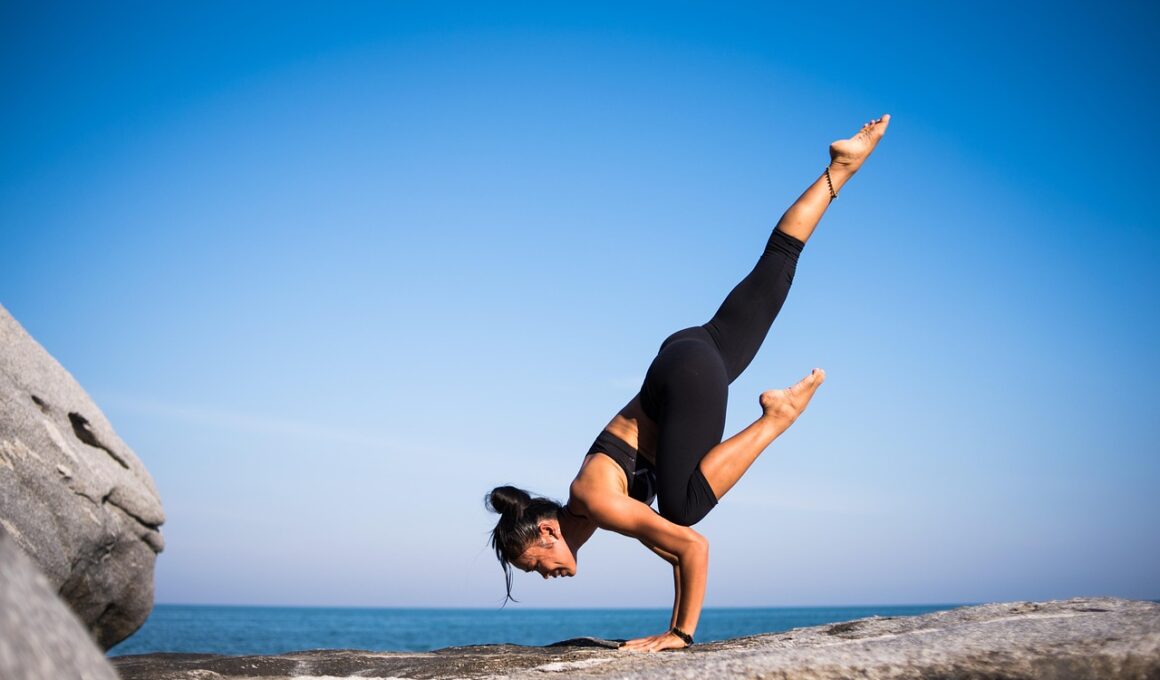The Benefits of Gentle Yoga in Chronic Injury Rehabilitation
Gentle yoga offers numerous benefits for individuals dealing with chronic injuries. Not only does it support physical rehabilitation, but it also enhances mental well-being. Incorporating gentle postures can help improve flexibility and range of motion, allowing for a smoother recovery. Additionally, gentle yoga can strengthen core muscles, providing stability and support to the affected areas. Breathing techniques and mindfulness practiced during yoga can significantly reduce stress and anxiety, often heightening the perception of pain. Thus, fostering a calm and peaceful mindset becomes essential during recovery. Moreover, the low-impact nature of gentle yoga minimizes further injury risk, making it an ideal option for rehabilitation. Many practitioners find that the supportive environment of a yoga class encourages socialization, reducing feelings of isolation that can come with long-term injury. Through gradual, gentle movements, participants often find they can regain strength and confidence. Regular practice helps to cultivate body awareness, essential for preventing future injuries. Lastly, incorporating gentle yoga as a part of a comprehensive rehabilitation program can enhance overall quality of life, promoting both physical and emotional healing in a supportive manner.
Understanding Gentle Yoga Techniques
Understanding the various techniques employed in gentle yoga can enhance recovery during chronic injury rehabilitation. First, focus on foundational postures, allowing muscles to adapt gradually without undue strain. Poses like Cat-Cow and Child’s Pose help to stretch and strengthen the back, promoting spinal alignment. Secondly, incorporate breath awareness by practicing pranayama; this can maximize oxygen flow to injured tissues. Slow, intentional breathing calms the central nervous system, facilitating relaxation. Thirdly, use props like blankets, bolsters, or straps to support the body during yoga sessions. Props help modify poses that might otherwise be challenging or painful, ensuring comfort while holding positions. Fourthly, encourage participation in restorative yoga classes which offer long-held poses, allowing for deep relaxation and release of tension. Gentle yoga frequently emphasizes mindfulness, drawing attention to sensations in the body, fostering greater self-awareness and acceptance. Partner with a qualified instructor who specializes in therapeutic yoga; their knowledge can guide the practice safely. Finally, be patient with your progress, acknowledging that healing takes time. Celebrate small victories, as they contribute to improved physical and mental health.
In addition to physical benefits, gentle yoga also addresses emotional aspects of chronic injury rehabilitation. For many individuals, dealing with a prolonged injury can lead to feelings of frustration, sadness, or anxiety. Gentle yoga helps create a space for emotional expression, allowing participants to connect with their feelings. Cultivating a sense of community in group classes fosters supportive relationships with others facing similar challenges. These connections can empower individuals by highlighting shared experiences and encouraging personal growth. In addition, the practice of self-compassion guided through gentle yoga nurtures a healthy attitude towards recovery. This acceptance serves as a vital component for emotional healing, promoting resilience. Additionally, visualization techniques can aid in establishing goals, reinforcing an optimistic outlook. The blend of movement, breath, and mindfulness in yoga helps to anchor individuals in the present moment, alleviating worries about the future. Overall, gentle yoga serves as a holistic approach that combines mind-body healing, promoting overall wellness. Thus, merging physical and emotional recovery allows for a well-rounded rehabilitation experience, encouraging individuals to reconnect with their bodies, boost morale, and strengthen mental outlook towards recovery. Taking time for oneself is crucial in this journey.
Incorporating Gentle Yoga into Rehabilitation Programs
Incorporating gentle yoga into rehabilitation programs can significantly enhance recovery outcomes for those with chronic injuries. It can be invaluable when complemented with other therapeutic interventions. Begin by consulting with healthcare professionals who can develop a well-rounded rehabilitation plan. Collaboration with physiotherapists or occupational therapists ensures that gentle yoga compliments other forms of treatment effectively. Customizing yoga practices to fit individual needs allows for individualized attention and support. Regular scheduling of yoga sessions fosters routine, further enhancing the rehabilitation experience. Attending classes led by trained instructors helps guide proper technique, minimizing the risk of re-injury. As progress is made, gradually introduce new and more challenging poses to stimulate continued development. Encourage cross-training by pairing gentle yoga with activities such as pilates or swimming, promoting overall fitness while addressing chronic injuries. Finally, consider incorporating meditation and mindfulness practices into yoga sessions to deepen mental engagement and focus. This comprehensive approach nurtures both body and mind, resulting in a more effective rehabilitation process. Participants often find that a blend of therapeutic methods empowers them, promoting independence, strength, and a sense of accomplishment.
Regular practice of gentle yoga allows for continuous improvement in the recovery process. One of the notable aspects of this type of yoga is its adaptability, making it suitable for people of all fitness levels, including those recovering from injuries. Importance is placed on gentle movement without overexertion. Individuals can gradually build strength, flexibility, and balance, which are crucial during rehabilitation. Additionally, yoga encourages better posture and alignment. This can alleviate pressure on injured areas, promoting healing while preventing future issues. Furthermore, creating a consistent practice fosters discipline and commitment to the recovery process. Establishing a regular routine cultivates an environment for self-care. Practitioners often report enhanced sleep quality, which is vital for healing and overall wellness. Encouraging mindfulness during practice fosters positivity, which can lead individuals to remain motivated as recovery progresses. Engaging in regular gentle yoga can reduce chronic pain by promoting better blood flow, oxygen delivery, and tension relief in tight muscles. These physiological benefits support recovery on multiple levels, helping individuals reclaim their active lifestyles. Thus, gentle yoga serves as a powerful tool in the rehabilitation journey, facilitating both physical and emotional recovery.
Success Stories of Gentle Yoga in Rehabilitation
Success stories of individuals who have utilized gentle yoga in their rehabilitation journeys reveal the transformative benefits of this practice. Many people report significant improvements in their physical capabilities, ranging from enhanced mobility to increased strength. For instance, some individuals with chronic back pain have found relief through gentle movements, allowing them to participate more fully in daily life. Additionally, numerous clients have shared their experiences of emotional breakthroughs that coincide with their physical progress. By integrating mindfulness into their routines, individuals have learned to manage stress and anxiety associated with chronic injuries better. Through consistent practice, participants often express feelings of empowerment as they regain control over their bodies and lives. Furthermore, support from others in yoga classes fosters a sense of belonging, confirming the importance of community during recovery. Each person’s journey inspires others, demonstrating that recovery is possible through dedication to gentle yoga practices. Long-term benefits are evident as individuals continue to practice well beyond their initial rehabilitation period, further improving their overall health. The spirit of resilience shines through these success stories, emphasizing that gentle yoga is a valuable component of chronic injury rehabilitation.
In conclusion, gentle yoga plays a vital role in chronic injury rehabilitation, offering numerous benefits that encompass both physical and emotional healing. Its adaptable nature allows it to be customized for individuals, regardless of their fitness levels, making it an essential tool in recovery. As practitioners engage with slow movements and breath work, they cultivate body awareness essential for progressive healing. The incorporation of mindfulness nurtures a positive mindset, which supports emotional recovery in tandem with physical rehabilitation. Additionally, the community created through shared experiences strengthens support systems, empowering individuals to persevere in their journeys toward healing. Physical therapists and healthcare professionals recognize the importance of integrating gentle yoga into comprehensive rehabilitation programs, as success stories continue to inspire others seeking relief. The blend of structure, safety, and support helps individuals reclaim their confidence, leading to improved quality of life. Gentle yoga serves not only as a means of physical recovery but also as a path towards emotional well-being. Ultimately, maintaining a consistent gentle yoga practice promotes holistic healing, allowing individuals to thrive and embrace a fulfilling life even after experiencing chronic injuries.


